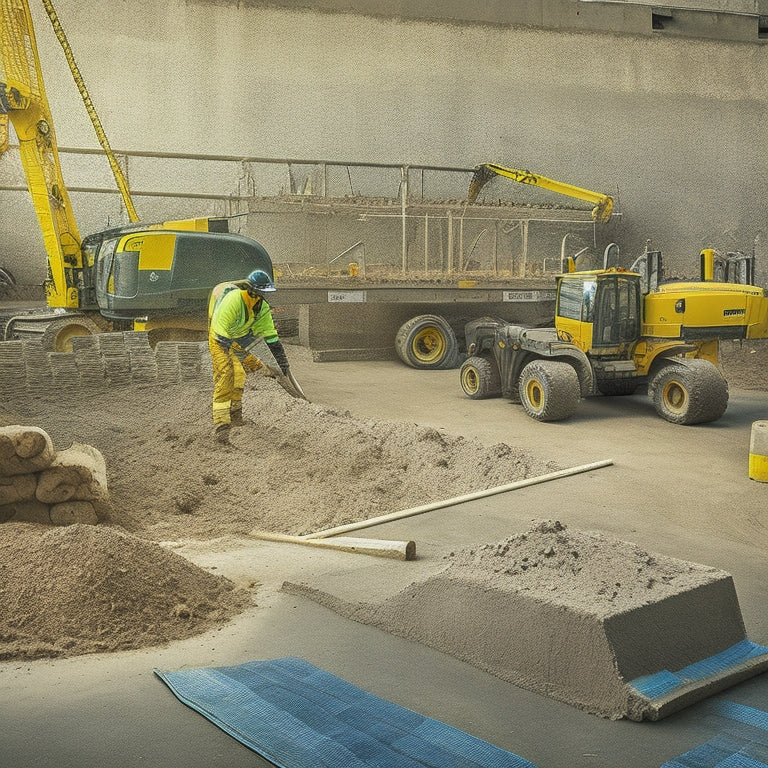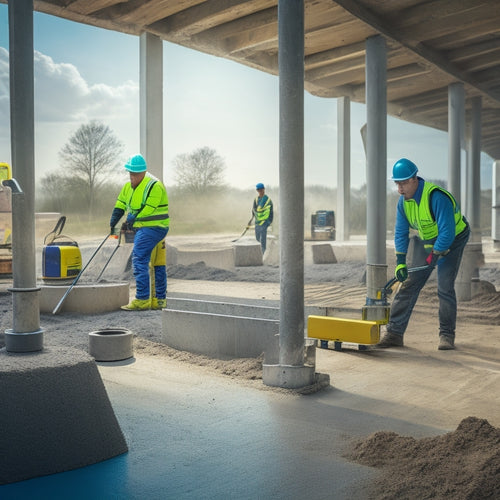
7 Crucial Tools for Laying Concrete Foundations
Share
When laying concrete foundations, you'll need to guarantee accuracy, precision, and quality to prevent costly mistakes and compromised structural integrity. To achieve this, you'll require a range of specialized tools. For starters, measuring tools like tape measures, laser levels, and framing squares are essential for precise dimensions and alignment. Next, level and plumb checks are vital, using tools like bubble levels, plumb bobs, and digital inclinometers. You'll also need precise distance measurement tools, angular alignment verification tools, compaction tools like tamping tools and vibrating plates, concrete mixing tools, finishing tools like screed boards and edging tools, and curing compounds for protection. By mastering these vital tools, you'll set yourself up for success in laying a strong and durable concrete foundation.
Key Takeaways
• Accurate measurements with tools like tape measures, laser levels, and framing squares are crucial for preventing costly errors and ensuring structural integrity.
• Level and plumb checks using bubble levels, plumb bobs, and laser levels guarantee correct foundation laying and prevent mistakes.
• Precise distance measurement tools like laser distance measurers, digital tape measures, and measuring wheels ensure accuracy down to the last inch.
• Angular alignment verification using digital angle encoders, laser levels, and theodolites is critical for foundation stability and structural integrity.
• Compaction tools like tamping tools and vibrating plates, as well as concrete mixing tools and finishing tools, are essential for achieving a uniform and high-quality concrete foundation.
Tamping Tools for Leveling
When building a concrete foundation, you'll need to verify the surface is level and even, which is where tamping tools come in. These tools allow you to compact and smooth out the concrete to the desired grade.
Tamping tools are vital for achieving a uniform surface, and the right techniques can make all the difference. You'll want to choose tamping materials that suit the job, such as hand tampers, plate compactors, or roller compactors, depending on the size and scope of your project.
Effective tamping techniques involve applying consistent pressure and overlapping strokes to guarantee thorough compaction. It's important to work in small sections, checking your progress regularly to avoid over- or under-compaction.
By using the right tamping tools and techniques, you can achieve a strong, stable foundation that will support your structure for years to come.
Remember to always follow safety guidelines and manufacturer instructions when working with tamping tools to guarantee a successful and accident-free project.
Concrete Mixers for Consistency
To guarantee a strong and durable concrete foundation, you need to mix the concrete to the right consistency, which is where concrete mixers come in, playing an essential role in achieving a uniform blend of cement, aggregate, and water. The right mixer can assure that your concrete is mixed to the correct consistency, which is vital for a strong and durable foundation.
There are different types of concrete mixers and mixing techniques to choose from, depending on the size and complexity of your project. Here are some common types of mixers and their features:
| Mixer Type | Features |
|---|---|
| Drum Mixers | Batch mixing, suitable for small to medium-sized projects |
| Pan Mixers | Continuous mixing, ideal for large projects |
| Twin-Shaft Mixers | High-speed mixing, perfect for high-strength concrete |
When choosing a mixer, consider the size of your project, the type of concrete you're using, and the mixing technique you prefer. By selecting the right mixer and technique, you can guarantee a consistent and high-quality concrete mix that will result in a strong and durable foundation.
Vibrating Plates for Compaction
When you're working with vibrating plates for compaction, you'll need to select the right plate for your specific job.
You'll want to take into account factors like the plate's weight, size, and vibration frequency to guarantee you're getting the best results.
Plate Selection Criteria
Selecting the right vibrating plate for compaction involves evaluating key factors, including the type of concrete, slab thickness, and soil conditions, to guarantee peak performance and efficient compaction.
You'll want to take into account the plate materials, as they can impact the plate's durability and ability to withstand heavy use. Steel plates, for instance, are sturdy and resistant to wear, while polyurethane-coated plates offer improved traction and reduced vibration transmission.
When choosing a plate size, you'll need to think about the area you need to compact and the accessibility of the site. Larger plates are ideal for open areas, while smaller plates are better suited for tight spaces or areas with obstacles.
Additionally, take into account the plate's weight and power output, as these factors will influence its ability to compact the concrete effectively. By carefully evaluating these factors, you can select a vibrating plate that meets your specific needs and guarantees a strong, even foundation.
Optimal Vibration Frequency
You'll need to pinpoint the ideal vibration frequency for your vibrating plate to achieve efficient compaction and prevent over-vibration. The preferred frequency depends on the type of concrete, its moisture content, and the plate's weight and size. Using the right vibration techniques can make a significant difference in the quality of the concrete foundation.
Here's a general guideline to help you determine the preferred frequency:
| Concrete Type | Preferred Frequency (Hz) |
|---|---|
| Low-slump concrete | 30-40 |
| Medium-slump concrete | 40-50 |
| High-slump concrete | 50-60 |
| Fiber-reinforced concrete | 25-35 |
| High-strength concrete | 60-70 |
Keep in mind that these are general guidelines, and the preferred frequency may vary depending on your specific project requirements. It's important to consult the manufacturer's recommendations and conduct on-site tests to determine the best frequency for your vibrating plate. By using the right vibration frequency, you can achieve efficient compaction, reduce the risk of over-vibration, and produce a high-quality concrete foundation.
Screed Boards for Smoothing
To achieve a smooth, even finish, use screed boards to strike off excess concrete and remove any imperfections from the surface.
You'll need to choose the right screed board type for your project, as there are several options available, including wooden, aluminum, and fiberglass boards. Each type has its own advantages and disadvantages, so select one that suits your specific needs.
When it comes to screed board techniques, you'll want to master the following:
-
Proper board angle: Hold the screed board at a 45-degree angle to effectively remove excess concrete and achieve a smooth finish.
-
Consistent pressure: Apply consistent pressure to the board to guarantee an even finish and prevent unevenness.
-
Smooth strokes: Use smooth, continuous strokes to move the screed board across the surface, removing excess concrete as you go.
- Regular cleaning: Regularly clean the screed board to prevent concrete from building up and affecting the finish.
Edging Tools for Clean Finish
Achieve a clean, defined edge by employing edging tools, which are specifically designed to remove excess concrete and create a crisp, finished look around joints, corners, and other areas where the slab meets other surfaces.
You'll be using these tools to refine the edges and corners of your concrete foundation, ensuring a professional-looking finish.
Edging tools come in various shapes and sizes, each suited for specific tasks, such as edging trowels, edging floats, and jointers.
When choosing an edging tool, consider the type of concrete, the size of the area, and the desired finish.
Mastering edging techniques takes practice, but with the right tools, you'll be able to achieve a smooth, even finish.
Remember to apply gentle to moderate pressure, depending on the tool and the concrete, to avoid damaging the surface.
Curing Compounds for Protection
Seven essential curing compounds are available to protect your freshly poured concrete foundation from environmental stressors and guarantee its long-term durability. These compounds play an important role in ensuring the foundation can withstand various weather conditions, traffic, and other external factors.
You'll want to take into account the following curing methods to provide ideal surface protection:
-
Acrylic-based curing compounds: These water-based compounds form a breathable film that prevents water loss and promotes uniform curing.
-
Wax-based curing compounds: These compounds provide a physical barrier against water and air, ideal for high-traffic areas or extreme weather conditions.
-
Silane-based curing compounds: These penetrating sealers react with the concrete to form a hydrophobic surface, reducing water absorption and increasing durability.
- Siloxane-based curing compounds: These compounds offer a combination of surface protection and waterproofing, making them suitable for foundations exposed to harsh environments.
Measuring Tools for Accuracy
When laying concrete foundations, you know that accuracy is essential, and that's where measuring tools come in.
You'll need to guarantee your foundation is level and plumb, measure distances with precision, and verify angular alignments.
Level and Plumb Check
You'll need to verify the foundation's level and plumb using specialized measuring tools to confirm accuracy and prevent costly mistakes. This vital step guarantees that your concrete foundation is laid correctly, providing a solid base for your structure.
To achieve this, you'll require the following essential tools:
-
Bubble level: A bubble level is a must-have for confirming the foundation is perfectly horizontal. This tool indicates even the slightest deviation from level, allowing you to make precise adjustments.
-
Plumb bob: A plumb bob is used to check the vertical alignment of the foundation. This tool consists of a weight attached to a string, which indicates when the foundation is perfectly plumb.
-
Laser level: A laser level projects a level line or plane, enabling you to check the foundation's levelness over a larger area.
- Digital inclinometer: This tool measures the angle of the foundation, providing precise readings to confirm it's within the required specifications.
Precise Distance Measurement
Accurate distance measurements are critical to guaranteeing your concrete foundation's structural integrity. To achieve this, you'll need to employ specialized measuring tools that provide precise readings. When it comes to distance measuring, you can't afford to rely on rough estimates or eyeballing it. Instead, you'll need to use measurement techniques that guarantee accuracy down to the last inch.
One essential tool for precise distance measurement is a laser distance measurer. This handheld device uses laser technology to calculate distances with an accuracy of ±1/16 inch.
Another option is a digital tape measure, which provides precise readings and can be used to measure distances up to 100 feet.
Additionally, you may want to take into account using a measuring wheel, which is particularly useful for measuring large areas or curved surfaces.
Angular Alignment Verification
Seven critical degrees of angular alignment must be verified to confirm your concrete foundation's structural integrity. This requires a set of specialized tools that can detect even the slightest deviations from the planned design.
To confirm accurate angular alignment, you'll need to employ precise angle measurement techniques. Here are four essential tools to get it right:
-
Digital Angle Encoders: These tools provide precise angle measurements with high accuracy, allowing you to detect even minor deviations from the planned design.
-
Laser Levels: By projecting a level plane, laser levels help you verify the angular alignment of your foundation, confirming it's perfectly horizontal or vertical.
-
Theodolites: These instruments measure angles in the horizontal and vertical planes, enabling you to make precise alignment adjustments.
- Inclinometers: These tools measure the inclination of surfaces, helping you detect any deviations from the planned angle.
Frequently Asked Questions
What Safety Gear Is Necessary When Laying Concrete Foundations?
When laying concrete foundations, you must adhere to safety regulations by wearing personal protective equipment, including steel-toed boots, hard hats, safety glasses, gloves, and respirators to minimize exposure to hazardous materials and prevent injuries.
Can I Use a Single Tool for All Concrete Finishing Tasks?
You'll find that a single tool can't cover all concrete finishing tasks, as different techniques, like tamping, floating, and edging, require specialized tools for ideal results, highlighting the importance of tool versatility in various finishing techniques.
How Do I Prevent Concrete From Cracking Due to Weather Changes?
You'll prevent concrete cracking from weather changes by controlling temperature fluctuations and moisture levels during curing, ensuring a stable environment that allows the concrete to set slowly and evenly, reducing stress and shrinkage.
Can I Lay Concrete Foundations in Extremely Cold or Hot Weather?
'You're brave to even think about laying concrete in extreme temperatures! But, yes, you can do it - just be prepared to employ cold weather techniques like insulating blankets or hot weather precautions like misting to guarantee success.'
How Long Does It Take for Concrete Foundations to Fully Cure?
You'll need to wait for the concrete to complete its curing process, which can take anywhere from 24 to 48 hours, depending on factors like temperature and hydration techniques, before it reaches full strength.
Conclusion
You've got the essential tools for laying concrete foundations, but don't underestimate their importance.
Did you know that according to the American Concrete Institute, nearly 75% of concrete failures are attributed to poor surface preparation and inadequate compaction?
By using these 7 vital tools, you'll guarantee a solid foundation that will last for years to come.
Remember, investing in the right tools is essential for a successful concrete project, and it's worth the extra effort to get it right the first time.
Related Posts
-

Best Tools for Concrete Restoration and Repair
When tackling concrete restoration and repair projects, you need a range of reliable tools to achieve professional-gr...
-

What Tools Ensure Precise Concrete Leveling Results
You need a range of specialized tools to achieve precise concrete leveling results. Laser leveling instruments provid...
-

Must-Have Tools for Concrete Planter Projects
As you commence your concrete planter project, you'll need a range of specialized tools to achieve professional-grade...


